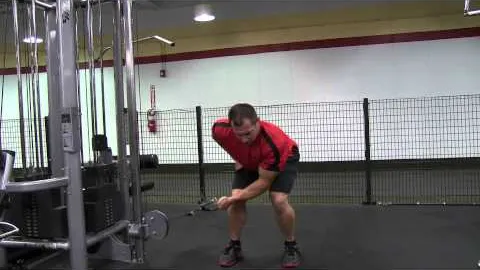
If you are looking to build stronger and more defined shoulders, incorporating the Bent Over Single Arm Cable Rear Delt Fly into your workout routine can be highly beneficial. This exercise specifically targets your rear deltoids, which are the muscles located on the backside of your shoulders. By isolating and working these muscles, you will not only improve your overall shoulder strength but also achieve a more well-rounded and balanced physique. In this article, we will guide you through the steps of performing the Bent Over Single Arm Cable Rear Delt Fly correctly and effectively.
Before diving into the exercise itself, it's important to understand why targeting your rear deltoids is crucial for well-rounded shoulder development. Many individuals often prioritize training the anterior (front) and medial (side) deltoid muscles, neglecting the rear deltoids. However, neglecting this muscle group can lead to muscle imbalances and potential shoulder injuries.
Strengthening your rear deltoids helps to improve posture, shoulder stability, and overall shoulder function. The rear deltoids play a vital role in pulling your shoulders back and maintaining proper shoulder alignment. By incorporating the Bent Over Single Arm Cable Rear Delt Fly, you can effectively engage and strengthen these important muscles, enhancing your overall shoulder symmetry and stability.
Setup: Start by attaching a D-handle to the low pulley on a cable machine. Grab the handle with your right hand and step away from the machine, creating tension in the cable. Position yourself so that your left leg is slightly in front of your right leg. Bend your knees slightly and hinge forward at the hips, allowing your torso to be parallel to the floor. Keep your back straight, chest up, and core engaged throughout the exercise.
Body Positioning: Stabilize your body by placing your non-working hand on a bench or other stable surface for support. This will prevent unnecessary movement and enable you to isolate and target the rear deltoid effectively.
Movement: With a slight bend at your elbow and maintaining a neutral wrist position, initiate the movement by pulling the handle towards your side. Imagine squeezing your shoulder blades together as you pull the cable. Focus on activating your rear deltoid muscle throughout the movement and maintain control.
Full Range of Motion: Continue pulling until your arm is perpendicular to your body, keeping your elbows in line with your shoulder and forearm. Avoid excessive movement of your torso or any swinging motion.
Return to Starting Position: Slowly release the tension on the cable and allow your arm to extend fully. Do not let the weight stack touch or rest between repetitions. Maintain control and a steady pace, avoiding rapid or jerky movements.
Repetition: Complete the desired number of repetitions for one arm before switching to the other arm.
To maximize the effectiveness and minimize the risk of injury during the Bent Over Single Arm Cable Rear Delt Fly exercise, keep the following tips in mind:
To optimize your shoulder development and the overall effectiveness of your workout routine, consider the following recommendations:
The Bent Over Single Arm Cable Rear Delt Fly is an effective exercise for targeting and strengthening your rear deltoids. Implementing this exercise into your shoulder workout routine can help you achieve well-rounded, defined shoulders while improving shoulder stability and posture. Remember to focus on proper form, maintain control, and gradually increase weights to maximize your gains. Combine this exercise with a well-balanced diet and overall fitness regimen for optimal results.
If you're looking for a gym, fitness club or yoga studio, you've come to the right place.
You can find information about gyms in your area. Browse catalog of gyms and find gyms with classes which are you looking for.
On gym page you can find simple information like address, phone or website. You can find list of available classes. You can check availability of personal training or small group classes. On place page you can also see information about open hours.
You can find gyms near you with amenities, courts, studios and equipments.
Use our map to find gym at your city or district.
In Gym Navigator you can find list of exercises with movies for many body parts.
You can browse exercises catalog and find exercises the best of you.
You can also find exercises grouped into workout plans, which you can use to improve you body. Each routine show you exercises one by one and give you possibility to count you progress and count down rest time.